Australian
and international
exploratory
performance and
media arts
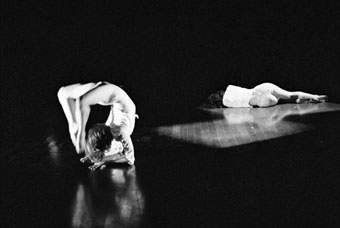
Inside Out
photo Heidrun Löhr
Inside Out
Art plunders the world, and other art, for its contents and forms. Dance in recent times has rapidly and inventively absorbed, among other things, break-dancing, martial arts, sports and the virtual bodies and worlds conjured by new media. The absorption of training regimes and sundry physical aesthetics into the body of performance is sometimes problematic, especially when the digestion appears incomplete and the audience are faced with the raw materials of uncooked art. The lesser disciples of Suzuki Tadashi, for example, have produced mere stomping demonstrations and Butoh-borrowers empty images of slo-mo angst. The power of integration vis a vis influence has been witnessed, to name only a few examples, in the work of Tess De Quincey, Nikki Heywood (eg performing in her own unforgettable Creatures Ourselves) and Sue-Ellen Kohler, dancer and yoga practitioner par excellence in her unique live dance and film creations. Kohler springs to mind when seeing Narelle Benjamin’s Inside Out. Benjamin, a virtuosic dancer with One Extra Dance and Chunky Move (and a filmmaker of considerable potential), here passes on her formidable skills to young dancers Kristina Chan and Clare Holland.
The admirably executed shapes, extensions and contortions of yoga dominate the work in a series of short scenes. It’s in the transition from shape to shape and movements within each posture that the choreographic sensibility is glimpsed, if insufficiently. Unconvincing scene-shifts, deployed via see-through black-outs, cut short the duration of movement that would test Benjamin’s vision. Even so, the sense of yoga showreel is lessened in the moments when the dancers’ bodies suggest alien forms (as in the opening, unfolding images) or serpentine liquidity in the mutating pools and columns of Simon Wise’s lighting. Less readable were the signs of torment in the performers and Huey Benjamin’s “noise” soundtrack, okay in itself but too big for this intimate bodywork. As the Sydney independent dance scene revivifies after some hard years, it’s heartening to see the passing on of skill and the emergence of a new choreographic vision.
On the same program, as 2 strangers on a park bench, Michael Whaites and Michael O’Donoghue play at waiting, drawing on the language of everyday gestures, rituals and anxieties, here elevated into the pathos of lost love (laboriously stated via soundtrack songs) and the discovery of each other as potential partners (neatly duetted). It’s a nice idea and it has its moments but mostly totters between shapelessness and episodes of over-articulation, between acute behavioural observation and a thin narrative. There’s something in Waiting for Michael, but it’s not been realised in this incarnation.
Film and video have become increasingly important to dance, not only for documentation but as significant means of expression for filmmakers, not least filmmaker-choreographers. To reflect on the ways film ingests dance was the wonderful opportunity One Extra offered an inquisitive audience when it hosted the appearance of UK artists Miranda Pennell and John Smith in Sydney. This followed a filmmaking workshop, with both artists also exhibiting works at Performance Space. Smith’s 30 years of eccentric, good-humoured and enlightening radical filmmaking opened up endless possibilities for visual creativity. In The Girl Chewing Gum (12 mins, 1976) his voice-over wonderfully ‘directs’ the movements of suburban Londoners as if they are his film extras. His Worst Case Scenario (20 mins DVD loop, 2003), comprising a stream of movie-like images from rapidly shot camera stills taken on a Vienna street corner, is an exquisite documentation of everyday waiting, eating and road-crossing, with just a whiff of Freud.
Pennell is a wonder, creating films with a choreographer’s sensibility but whose subjects are movers of a different kind—marching soldiers (Tattoo, 9 mins, 2002), people dancing in their living rooms (Human Radio, 9 mins, 2001) and girl ice-skaters and boy guitarists (Magnetic North, 8 mins, 2003) shot in Finland. Pennell bravely showed some of her early idiosyncratic creations featuring herself, proof that the real world is her meat but that the way to it is indirect, but nonetheless intriguing. One Extra’s commitment to “film dance” whether here or in the reel dance festival provides a key stimulus and focal point for the making, understanding and display of this expanding creative form in Australia and beyond.
One Extra Dance, Inside Out, choreographer Narelle Benjamin, performers Kristina Chan, Clare Holland, lighting design Simon Wise, noise Huey Benjamin; Waiting for Michael, directors, performers Michael Whaites, Michael O’Donoghue, dramaturgy Robert Jarman, lighting Tim Munro, composer/sound designer Ben Sibson, set design Greg Methe; Dec 3-14. reel dance, films by Miranda Pennell and John Smith, screenings Dec 6-7, installations Dec 3-13, Performance Space, Sydney 2003
RealTime issue #59 Feb-March 2004 pg. 31
© Keith Gallasch; for permission to reproduce apply to realtime@realtimearts.net
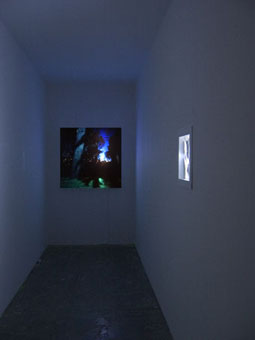
Jo Scicluna, from a slow dark light
The greatest challenge for the contemporary visual artist is capturing the audience’s undivided attention. Art is getting bigger, louder, and bolder every minute, and the death of contemplation seems imminent. In this regard Jo Scicluna’s recent exhibition was unusual. from a slow dark light is a journey of 2 kinds, both territorial and spiritual.
At BUS (a Melbourne artist-run gallery) there is a narrow passageway that goes nowhere. At its end Scicluna has installed a large photograph of a nocturnal landscape illuminated by a lightbox and, halfway down the gallery, a small wooden construction made of contour-map jigsaw forms. The lightbox is like a window to another world, drawing you to the end of the space. On the other hand, the wooden construction, built into the wall and dimly backlit, is only noticeable when you pass it.
Landscape is often used as a metaphor for existential yearning, the nocturnal image even more so. The photograph in from a slow dark light is of a suburban park at night. It’s a spooky image. Two trees in proscenium arch formation frame the scene and the shadow of a third tree is strongly cast across them. What a looming shadow it is, animated like a tree from a haunted forest. Beyond are the distant lights of the city, but they are blurry and out of reach. Like walking through a park at night, the danger is prescient. Light is used here as a central element, but it’s the dark that prevails, our gaze drawn into the depths of the shadows. It’s the dark night of the soul and darkness might swallow us up.
Lightboxes are seductive. They embellish images and lend them theatricality. The allusion to cinema is often made but in this case Scicluna probably employed the device for other reasons. In from a slow dark light the visual relationship of the 2 components exists primarily through the technique of backlighting. Illumination from beyond was a device of Romanticism in its celebration of the Sublime and its evasiveness—what is missing is meant to keep you searching.
Scicluna’s contour construction is a graphic representation of the formal patterns of light and dark in the photograph. It is here that the 2 elements of the work magically meld despite appearing quite contradictory. The wooden contours speak of analytical thought, in contrast with the sublime experience of the landscape. Which is more real? The topographical map is a formula for space, an index in which both real and virtual coexist. But we are more likely to trust in the photograph as evidence of something real. Even so, Scicluna’s image is difficult to trust. It is beautiful, but feels like an illusion. It has all the staginess of trompe l’oeil and about as much reality as a Claude Lorrain painting. The one fact of the photograph remains—it appears to be the archive of a moment, a passage to the past.
Michelangelo Antonioni’s film Blow Up (1966) is about a prominent British photographer (played by David Hemmings) who discovers, as he enlarges one of his pictures in the darkroom, that a murder has taken place within his frame. In the scene where he is working with his enlarger, the movie camera zooms in on the photo of the park and the ambience of the room is replaced by the sound of wind and rustling trees. The suggestion is that in the absence of seeing a greater truth exists. Jo Scicluna’s work is just as suggestive—something strange emerges from a slow dark light.
Jo Scicluna, from a slow dark light, BUS, Melbourne, December 2-20, 2003
RealTime issue #59 Feb-March 2004 pg. 32
© Lily Hibberd; for permission to reproduce apply to realtime@realtimearts.net
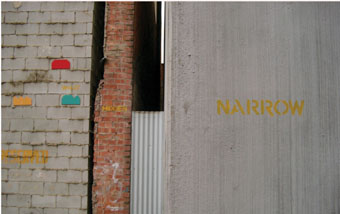
Nick Harding, Narrow, 2003
photo Linda Marie Walker
Nick Harding, Narrow, 2003
Recently, while visiting Jim Moss’ new house/studio, designed by the late Nick Opie, I saw an ‘exhibition’—2 paintings by Ian Grieg, one a patterned black work in 2 parts, the other a grid of a repeated water image. Both were Grieg’s gifts to the house. In Kay Lawrence’s office around the corner from mine in the city are many exquisite woven works by various artists (including Lawrence). Across the road in a streetwear shop is a set of prints by the urban artist KAB 101 (shown to me by Anton Hart). And a little further down Hindley Street on an old cinema hoarding there is this sign:
BLOTCHWOMAN>KAB101>SPROUTBOY
PRESENTS
VOID IF REMOVED
(Beneath this sign is a whole ‘cinema screen’ of characters, scenarios, colour fields and texts; the cartoon face of Blotchwoman, for example, has appeared throughout Hindley Street over the last few years—she’s a ‘filmstar’ of the West End). In artists’ studios there are innumerable works that never see the light of day. On my own loungeroom wall there is a new John Barbour work.
Sometimes, perhaps always, there is art ‘all around’—not organised to be officially viewed, or offered as officiated presentation, but nevertheless ‘exhibitions’ that one sort of bumps into. Then there are, in more ordered and contained ways, sites where art appears outside designated galleries, like shop fronts, artist-run spaces, clubs, library foyers, corridors etc.
In the ‘all around’ premise, art and architecture become the ruins (or erosion) of each other. They take within themselves—absorb their own appearance, as if holding themselves to themselves—the singular presence of their appearance in the world as odd, as stubborn manifestations of conscious effect. What I mean is that art and architecture, when they appear together like this, resist incorporation—however mild—into the straight-line of dominant (art) sense, and wind up in the middle of contrary stories. A shattering beauty results. The black Grieg is high above the silver stove, catching the summer light from the west. It’s as if one ‘finds’ it there. One finds, in some way—by chance or invitation—these works and their architectural context (in the case of the Grieg, one’s eye is drawn to the height of the wall, and to the upstairs space).
And then…one finds entire (planned) exhibitions right under one’s nose (and just a little to the side of the galleries one usually haunts expectantly) which seem to be about—or so one imagines—the very idea of space-gift, of the ‘found’, of what is there (in the present) for the taking.
In his first solo exhibition NARROW, Nick Harding has used the limited space of the Flightpath Architects’ office to arrange a set of small digital photographs taken within a 100m radius of the space. These poetic, quietly composed images are each of a liminal or marginal space, an everyday architectural moment of endurance—an infinite moment of abandonment; the compositions are only just there—chosen from a tiny territory that effortlessly offers endless imagistic opportunities. Here in the strict angles of architecture—brutal corners, gaps, planes, grids, materials—a ruinous activity of surface subtraction and addition undoes and redoes the appearance of the world, as if an art of constant reworking (“sweet disorder”, says Jane Rendell in Occupying Architecture, Between The Architect And The User, ed Jonathon Hill, Routledge, London & New York, 1998). There, where no-one’s looking, stories come and go, the city’s undercurrent messes with its wrap of staid geometry, pulls it out of alignment and occupies it. The wrap is an invitation, an offered surface—the word NARROW in yellow on a grey concrete wall, with the word HIDDEN on the bricks nearby; a compelling Mondrian, by ‘someone’, appears in aqua and blue on the back of a building. This ‘someone’ is a crowd, an amalgam of strange energies, which employs strategies to liquefy the meaning of space; the space of architecture is borrowed and given its proper due—a love without judgment. Time, ‘someone’, shifts it ‘all around’; Harding records 11 shifts of time.
Jason Namakaeha Momoa makes 3-dimensional collages from the fragments of time left lying around on streets and rubbish tips, in sheds and shops. Not revelations nor didactic evocations, the collages are all brownish, modest, worn and crumbly. They are ‘poems’ which trust that their materiality—in its acquired broken, ruined, melancholy beauty—will not be dismissed via the language of nostalgia or longing, but will be taken on in other less ready terms (like, corrosion, accretion, duration, and attention—an attention of minute intensity, eg why has that small cardboard box been reinforced with metal strips?; to what picture did those canvas prayer flags once belong?).
Namakaeha Momoa’s solo exhibition, The Brown Bag Diaries, is hung in the central space of Kintolai Gallery, right next door to Harding’s exhibition at Flightpath Architects. The 10 mixed-media works, in their role as ‘collage’ or ‘construction’, belong to the long history and tradition of making-do, combining and juxtaposing (although juxtaposing, as a way of infusing ‘meaning’, is of little concern here; each element pretty much keeps its own counsel) with exceptions if one bows to clues. Several of the works use the back of picture frames as the ground/surface on which to apply other minimal materials—a piece of barbed wire (Hokusi), a drink coaster (Eye Of The Holder), a metal disk (Barn Burned Down Now I Can See The Moon)—and these grounds are themselves rich, porous, and textured, whole regions of nuance.
Viewed together these 2 exhibitions speak in similar tongues. In Harding’s work the collage is ‘found’ and left in place, yet ‘taken’ too—extracted pictorially. In Namakaeha Momoa’s work the collage is found in disparate pieces in disparate (local) places, physically ‘taken’ and ‘given’ back out of context and architecturally ‘planned.’ They look like maps of curious interiors or floor plans for future structures: “Things in ruin give shape to the new structures, they are transfigured and changed. Like the tail of a comet they detach themselves from the cathedral. The whole world and the whole memory of the world are continuously designing the city” (Alvaro Siza in Bruno Marchand, “Inspired By Ruins”, A + U, 355, 2000).
One comes across these 2 bodies of work, they emerge within the wider circle of the contemporary visual arts and perform (consort) with the works one finds ‘all around.’ They gather, momentarily, a crucial imminence, or in Harding’s exhibition notes about liminal space, an “ambiguity; a marginal and transitional state, a transitional passage between alternate states…neither one place nor another; neither one discipline nor another; rather a third space in-between.” And, to extend this notion of ‘neither/nor’, across the street (Hindley Street, one of the great small streets in the world, let’s hope it doesn’t get cleaned to death) from both these exhibitions is the State’s organisation for the arts, Arts SA. Within these offices is an extensive exhibition of South Australian art curated by Julie Henderson and Joe Felber that will go ‘unseen’ by almost everyone—neither public nor private. This brings up, into the political cultural arena, the necessity (and urgency) for a location—an architecture (one of those sites recorded by Harding, and fantasised via an amalgam of Namakaeha Momoa’s ‘floorplans’, for example)—dedicated to the collecting, curating and showing of South Australian visual art (an archive, research facility, gallery, a site for events, residencies, education). A location that seriously takes up (consolidates and extends) the multifarious and complex work of our contemporary visual art spaces, commercial galleries, the state-wide South Australian Living Artists Week, artist run projects, studios, offices, shops, sheds and lounge rooms.
What Harding and Namakaeha Momoa’s exhibitions ‘exhibit’ is an indication of the vast passing of ‘local’ imaginings and intimate sensibilities which if valued and attended to would help reveal the specific and manifold resonances that a particular human environment is—in its extraordinary ‘doing’ endeavours. “Through telling new stories, the unknown, undiscovered city can be laid open to critical scrutiny, to new urban practices, new urban subversions…I would like to suggest that the unknown is not so easily known—indeed, it may be all too visible, right in front of our eyes…” (S. Pile in Rendell, Occupying Architecture, Between The Architect And The User).
Thanks to the artist Joe Felber for a conversation about the huge uncollected collection.
NARROW, Nick Harding, Flightpath Architects, Hindley Street, Adelaide, Dec 2003-Jan 2004; The Brown Bag Diaries, Jason Namakaeha Momoa, Kintolai Gallery, Hindley Street, Adelaide, Dec 2003-Jan 2004
RealTime issue #59 Feb-March 2004 pg. 34
© Linda Marie Walker; for permission to reproduce apply to realtime@realtimearts.net
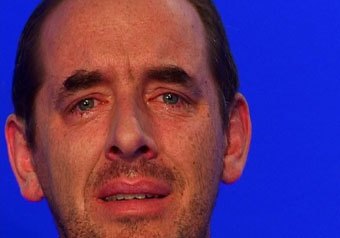
Lyndal Jones, Crying Man, 2003
Courtesy Anna Schwartz Gallery
Lyndal Jones, Crying Man, 2003
Projekt#6 is the final instalment in a series of 6 compilations of recent video art produced by Australian artists. Initiated in 2000 by video artist Brendan Lee, who funded and curated the first 2 issues before securing support for the subsequent archives from the City of Melbourne, Projekt provides an invaluable archive of the development of video art as an emergent and dynamic force in Australian art. It addresses the key questions of accessibility and exposure raised in the Video + Art = ? forum (see RT-Performance Space forum transcripts).
During my pre-Christmas visit to Kings artist-run studio in Melbourne, Lee loaded me up with videos, a DVD of Projekt#1-6 and the URL for the Projekt website (www.projekt.com.au). For the first time I coveted my neighbour’s home theatre. The ability to move between works, DVD, video and the website make this archive versatile and accessible. While the archive in no way replicates the experience of the work in the gallery space, as envisioned by the artist (and this certainly affects those video pieces which have been exhibited as site specific installations such as David Noonan and Simon Trevaks’ SOWA), it does enable a different and interactive engagement. It establishes a context in which to think about the work that video does.
For Lee, video art begins and ends with a question, whereas film tends to be self-contained and plot-driven. He feels that video or video art’s relationship to film is like comparing a poem to pop music. While poetry is intended to make you think and reflect, pop music offers pure distraction. This assessment is borne out in several videos which take the video clip as an incitement for their work. Kate Murphy’s Britney Love draws on her own and the fictional 11 year-old Brittany Love’s fascination with Britney Spears to reveal the incongruous relationship between highly sexualised pop video clips and their primary audience: young, mainly female viewers. In the production, young Brittany performs a highly evocative and sexualised dance routine to Crazy as she reveals her total preoccupation with a kid’s life: school, Spears and her hopes and dreams. In their video, Versus (Projekt#3), The Kingpins also draw on the conventions of the music video clip, using irony and parody to reinterpret traditional stereotypes within a cross-section of music genres. Although critiquing these constructions, the artists betray their own debt to the genre. Unlike the video clips they imitate, The Kingpins see themselves as “cheap imitators, simulating pop icons and pillaging media stereotypes, giving birth to their own reinventions.”
In Lyndal Jones’ Crying Man 1 (2003), the questioning nature of video is shown at its starkest. This work offers no narrative or resolution to the puzzle of why this particular man is crying. Here, as Jones explains, “there is no background that could anchor the tears in a particular incident, no words spoken that could explain the situation, no music to manipulate our emotions or our actions. We are free to watch him cry, to stop him or to leave.” Similarly, Alex Gawronski uses minimal means to achieve a gravity of situation. In Territory, Gawronski uses the medium to explore the covert relationship between art and war. While nothing really happens, he creates a palpable tension through his use of viewpoint, slowed down action and selective references to formalist traditions—banners, flags, uniforms and ritual—in the lead up to a political procession.
A feature of much of the work included in this archive is the simplicity of technique and approach. In contrast with what Keely Macarow (RT 54, p22) has termed the “cyberish polish invested in much ‘new’ media art”, many artists in this collection seem more interested in exploiting the gritty low-tech potential of video to raise questions. Leslie Eastman’s Erasehead (Projekt#5) and Daniel von Sturmer and Meri Blazevski’s Driveway Sequence (Projekt#5) are both successful precisely because of their awkwardness. In comparison, Alysa McHugh’s Suspension (Projekt#4) makes use of a sophisticated and self-conscious film noir technique, while Laresa Kosloff offers refined simplicity in Swell (Projekt#2).
All the works included in Lee’s archive have been shown previously in either private or public galleries in Australia. In a sphere where artists are closely aligned with galleries, Lee had to deal with the sensitive issue of protecting both artists’ and gallery rights. In negotiations with the galleries, Lee made it clear the Projekt was not selling the copyright or artist’s right and that a major spin off from the archive was promotional. As part of the arrangement with the galleries, Lee undertook to send the archive to every curatorial institution in Australia and promote it overseas. The scope of his vision, his charisma and enthusiasm, the promise of national and international exposure (for both artists and galleries) and the tangible results, overcame any concerns that the galleries might have had and they’ve enthusiastically supported the archive.
Lee’s next entrepreneurial venture is to make money for these video artists. As he sees it, art buyers will invest in photographs or video stills, yet still don’t really know what to do with video. At the forthcoming Melbourne Affordable Art Fair, Lee plans to circumvent such buyer resistance—buy a photograph or framed video still and get a DVD of the video.
In offering an archive of contemporary video work, Projekt introduces video to wider audiences in a way that is no longer dependent on the gallery context. It also provides a rich historical and educational resource for artists and scholars. One can only hope that ongoing funding will be found to enable the growth of this valuable resource. However it will not be able to rely on the restless and irrepressible energy of Brendan Lee. He has other plans and projects including his own video work. He will be participating in VideoSpell 3 Reanimate at Performance Space, Sydney from February 25 this year.
Projekt 1-6, quarterly video catalogue, DVD; curator Brendan Lee
RealTime issue #59 Feb-March 2004 pg. 33
© Barbara Bolt; for permission to reproduce apply to realtime@realtimearts.net
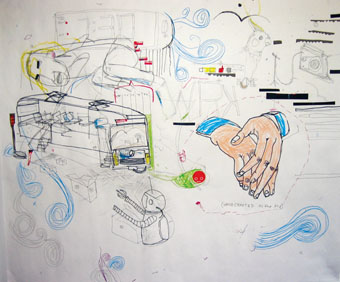
Brad Cook, Handmade
A graduate in Visual Arts from the University of Western Sydney, artist Brad Cook currently works in youth radio and has been an ARIA nominee 3 times for album cover design. His ‘stream-of-consciousness’ drawings tap the immediate environment, particularly television, the internet and the quirks of short-term memory. Cook’s intuitive approach means that the idea, the mark, and the construction spring literally from the moment.
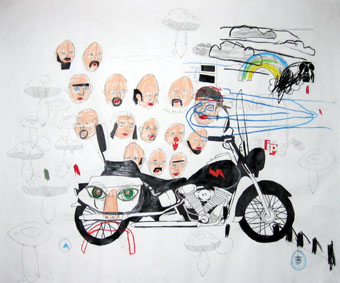
Brad Cook, Biker
Brad Cook is represented by Barry Keldoulis GBK Gallery 19 Meagher Street, Chippendale, Sydney, 0414 864 445, www.gbk.com.au
RealTime issue #59 Feb-March 2004 pg. 35
© RealTime ; for permission to reproduce apply to realtime@realtimearts.net
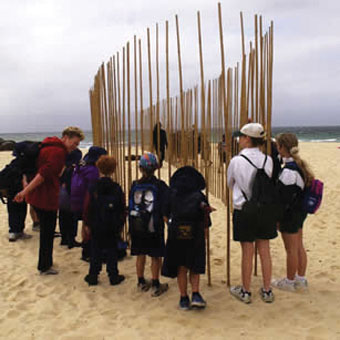
Mireille Astore, Tampa
photo Mario Bianchino
Mireille Astore, Tampa
How did you get in?
…How do you get out?
Do you get tired walking up and down?
Do you get bored?
…Excuse me…excuse me…excuse me!
Are you allowed to talk?
Are you the artist?
Are you part of the artwork/sculpture?
Are you meant to be in there?
What’s in the suitcase?
What’s this about?
Thank you for doing this!
You’re sick in the head!
Brilliant…very clever…congratulations!
Do you speak English?
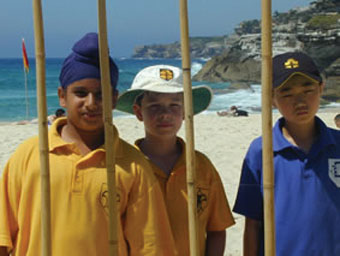
Mireille Astore, Tampa
photo Mireille Astore
Mireille Astore, Tampa
Ranging from abuse and hostility to identification, curiosity and concern (including a touching handwritten note passed through the bars), reactions to Mireille Astore’s sculpture/performance on Sydney’s Tamarama Beach read like a palimpsest of the wider public mood on asylum seekers.
From her lonely cell of bamboo stakes, Astore documented the responses of passers-by to her 18-day ‘internment’ as part of the 2003 International Sculpture by the Sea Exhibition. Her photographs capture the iconic beach, foam-capped waves, lifesavers, schoolkids and tanned bodies that surrounded her 24.6m x 3.2m patch of sand inside the bars.
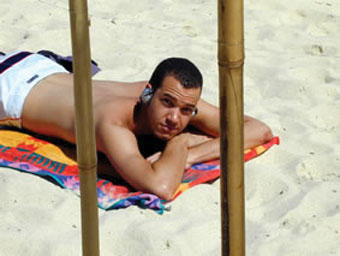
Mireille Astore, Tampa
photo Mireille Astore
Mireille Astore, Tampa
Astore’s Tampa referenced the rescue of asylum seekers from a leaking boat by the Norwegian ship Tampa after the Government’s refusal to let them ashore before the 2001 elections. Amid the swimmers, personal trainers and sunbathers, Astore built her cage of 2.1m bamboo bars, each 15cm apart, in a scaled-down version of the Tampa. Carrying all her requirements in a suitcase, she inhabited the cell from 10am to 6pm for 18 days. Through photographs and diary entries she recorded the responses of passers-by, later posting these on her website. (www.crixa.com/mireille/Migrant/Tampa.htm )
Group of young girls: “Excuse me…why aren’t you talking to us? Are you supposed to be in there? We want to get in…damn it! Why don’t you talk to us? Nah! Nah! Nah! We vote One Nation. You’re probably a filthy rich bitch! Why don’t you go home and cook dinner for your husband?…Look, did you see that? Even Americans were talking to us and you’re not. Who do you think you are?”
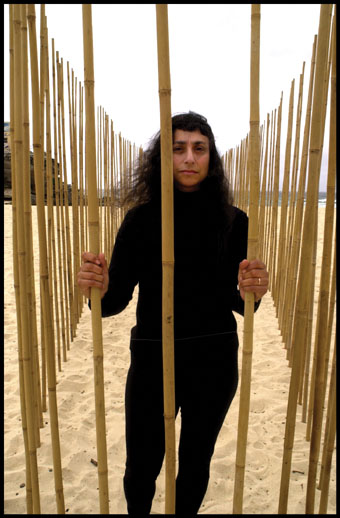
Mireille Astore, Tampa
photo Mario Bianchino
Mireille Astore, Tampa
Astore’s transcript of exchanges reveals a public at turns admiring and admonishing. While some people insisted she interact with them or made offerings of food and drink, others considered her work an incitement, giving them license to vent their opinions. On her website diary, Astore records the following:
“A football lands on me inside the Tampa where I am sitting immobile for the last hour. It was thrown by a group of young adults. They ask me, ‘Excuse me could you pass the ball? Hello…can you pass the ball please? Will you do us a favour and pass the ball?’ A man [interrupts]: ‘Would you ask a person in detention now to do you a favour? This is real…this is happening now!’ A middle-aged woman: ‘Come on, be nice to them and pass them the ball! It’s only a sculpture!’ The young woman from the group slithers through the bars and grabs the ball. I break my silence and tell her that she disappoints me. The same middle-aged woman: ‘That’s not a very nice thing to say!’”
Astore writes, “The inversion of the gaze as an exploratory tool and an illustration of the privileged artist’s position were critical to the outcome…the sculpture and performance acted as a dichotomy between the sense of freedom and grandeur the individual experiences at the seashore and the imprisonment refugees faced as a result of their trust in the most basic form of humanity at that seashore”.
Just as assumptions and generalisations abound about the stories and personal details of asylum seekers, Astore’s performance generated similar responses, with some passers-by wanting to impose their own, often stereotyped versions of how she should look, behave or perform:
Anonymous: “It’s hot in the sun, isn’t it! Ah! well! You’ve got the skin for it!”
Male photographer with tripod: “Excuse me, could you please stop walking and sit on your suitcase with your head cupped in your hands. Please… please…please…”
Young man to group of friends: “Hey…she’s Lebanese like me!”
A fellow artist in Sculpture by the Sea: “Mireille! This is an aggressive piece, you must explain it to people when they ask you. Most people don’t understand art!”
A woman sunbather in a sarong: “You’ve been here a week now, have you discovered yet what it’s like to lock yourself up?”
A video of the work and the complete set of 200 photographs Astore took throughout the project will be shown at Conny Dietzschold’s Multiple Box Gallery, Sydney in June this year. It will also be shown internationally at the National Museum of Contemporary Art Bucharest in Romania in February.
Tampa, Mireille Astore, Sculpture by the Sea, Sydney, Oct 30-Nov 16, 2003
RealTime issue #59 Feb-March 2004 pg. 36
© Mireille Juchau; for permission to reproduce apply to realtime@realtimearts.net
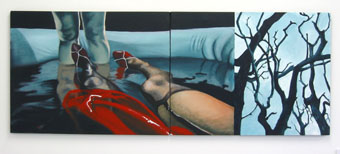
Christiana Edwards, Wet, 2003
photo Neil Haddon
Christiana Edwards, Wet, 2003
There is surely no need to ask, these days, if photography has killed painting. While both are strong and successful artforms, the hybrid of the 2 has created, if not a new medium, then, in many cases new ways of working with and viewing these popular expressive forms.
A good example is the group exhibition Real Space at Hobart’s newest non-commercial gallery and sole artist-run space, Inflight. The initiative supports the work of young and emerging artists and in just one year has become a vital part of the city’s art scene. It is an accessible, central venue contributing greatly to the arts in Hobart with strong solo and group shows. In the latest exhibition, Real Space there are some intriguing flaws and a certain lack of resolution in some pieces, but this only makes the show more interesting.
As the artists in Real Space acknowledge, “digital photography and image manipulation has profoundly affected the way many contemporary painters construct their paintings” (media release). The camera can be used as a device to create a mood, narrative or environment. The 5 participating painters have integrated photography and digital imaging into the evolution of their images. Using these techniques they contend that it’s possible to reinvent and modify our perception of reality.
The artists take different approaches and use different subject matter while addressing “…what space to put into a picture. It is a mediated space”—layered, digital or photographic. “It may not be the space of the real world or the virtual world, but it is the real and palpable space of painting” (media release).
The paintings here range from photorealism to abstraction and quasi-abstraction. Artists have used computer-generated images to create working studies for paintings and to conceptualise space within their 2-dimensional works. While photography has lent itself to such art making for decades, the effects achievable with computer imaging—the layering of digital images and mixing pixels—are especially appropriate to painting.
Among the most interesting works are David Salter’s vividly figurative What, where and A Place to Go, the former featuring a Munchian screaming child against a sinisterly enveloping background of a stark brick wall and writhing vines. The latter work depicts a bikini-clad figure in a strikingly-rendered swimming pool and both paintings “…are collaged, layered images from various digital sources, …portraits constructed [by] placing the figure in digitally manipulated unreal space [to] visually capture a state of mind” (artist’s statement).
Andrea Warren’s digitally constructed works, Zoom 1, 2 & 3, explore the world of bureaucracy and in their realism, use of light, cropping, skewed perspective and monotonal colour, strongly reflect the influence of photography. They feature large-scale close-ups of subjects such as office furniture and a reclining cropped figure, feet in the foreground and hands folded on his torso, again referencing the photographic. Warren explains, “Issues such as voyeurism, power struggles, identity within bureaucracy and the politics of the office environment are pivotal focuses within this investigation.”
Abbey MacDonald’s paintings explore the rather odd idea of flesh as fabric; somewhat unreadable works in carnal pinks and browns depict cushion-like forms that recall body parts. “The use of photography is vital for my work when searching for source material and digital imaging has been necessary when trying to create a flesh/fabric hybrid and make visual these specific points of tension,” says MacDonald. These are technically competent works, but not always visually seductive, except in their strangeness, and their premise is tenuous.
Julie Jacobs’ patterned canvases are inspired by the landscape, specifically the Tasmanian midlands. Some of her untitled oils seem overworked to the point where colours have become muddied and they seem to owe rather a lot to the landscape work of Richard Wastell, one of Hobart’s most significant young painters. Her use of repetitive design and texturing nevertheless shows potential.
Christiana Edwards’ explorations of the visual conceits of film noir and contemporary scary movies—referencing beauty, fear, sexuality and violence—transfer well to the canvas and add another dimension to an engaging show.
Real Space, Christiana Edwards, Julie Jacobs, Abbey MacDonald, David Salter, Andrea Warren; Inflight Gallery, North Hobart, Nov 28-Dec 19
RealTime issue #59 Feb-March 2004 pg. 37
© Diana Klaosen; for permission to reproduce apply to realtime@realtimearts.net
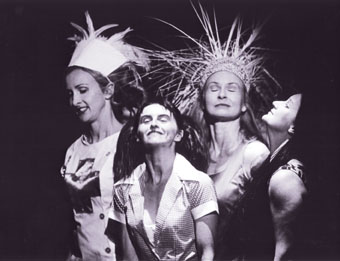
Still Angela
photo Jeff Busby
Still Angela
After what seems inordinate waiting, just too much realtime, even for a contemporary art space, the future for Sydney’s Performance Space suddenly looks brighter than it has for years. A new home for the national centre for contemporary art and hybrid performance has been confirmed, a 12 month program announced for 2004 and ventures in national training and touring realised. Director Fiona Winning, Associate Director Blair French and Chairman of the Board Tim Wilson announced these developments at the 2004 launch (December 9, 2003), replete with riotous performance excerpts by version 1.0 and The opera Project from the coming program and a flaming pink birthday cake to celebrate PS’s 21 years.
Winning was pleased to be able to say, instead of declaring another crisis, “We’re here, we’re healthy, we’re almost 21 and we’re looking forward to another dynamic 3 years in this space we’ve called home since 1983.”
Retro
Blair French said that the birthday would provide an opportunity “to share anecdotes about art that was made here, debates that have raged here, people that have worked here—artists, administrators, board members, technicians, front-of-housers. There’ll be a birthday party late in the year and a symposium looking at some of the major streams of work that emerged in our first 21 years. And an exhibition that traces the lineage of queer performance work here.”
Living-in
Instead of the usual announcement of a quarterly program (not a little determined in the past by funding body timetables) Winning was proud to be able to present a full program in 2004, “a mix of our own productions, co-productions with peer organisations and artist-initiated projects.” She began however with residencies, a reminder that the primary importance of PS is not solely its status as a venue or even a producer but as a nurturer and hub to a vigorous hybrid arts community. Winning explained, “In a broader political context where research and development is increasingly devalued, our residency program…offers critical research and development time to 6 collaborative teams of hybrid practitioners throughout the year. In the last 3 years, one residency each year has succeeded in securing support to go to production and one each year has secured further development support.”
In 2004, residency artists include dancer/choreographer Rosalind Crisp who will return from Europe to collaborate with local artists on her new work Duck Talk; new media artist Keith Armstrong and members of the Transmute Collective from Brisbane will develop their Intimate Transactions project (see p20-21) ; and visual artists Gordon Hookey and Deborah Kelly who will, French said, “continue their ongoing conversation regarding issues of whiteness, blackness, place and the contest for Australian history via a process of learning to literally animate each other’s representations of land.” A number of these and other residencies will be programmed simultaneously in the theatre, the galleries and the studio in the Head Space open laboratory event with showings in early August.
At home & abroad
Winning and French described 3 major national and international projects scheduled for 2004. The third Time_Place_Space laboratory in partnership with PICA, ANAT and the Australia Council will involve 20 artists from around the country converging at AIT Arts in Adelaide, working with 5 facilitators including Marianne Weems, director of New York’s Builders Association (see interview RT57 p28) and Clare Grant, performance-maker, dramaturg and academic currently working at the University of New South Wales. The second project is Breathing Space Australia, a collaborative project between Arnolfini, a contemporary art space in Bristol, PICA and Performance Space, that brings together British and Australian hybrid artists and curators in an ongoing exchange. In 2004, Breathing Space will present works by UK and Australian artists that will tour Sydney, Perth and Melbourne. In 2005, the Australian work will tour the UK and be presented at Arnolfini’s Inbetween Time festival and at Tramway in Glasgow.
The third project, and one of considerable long-term significance, is the launch of a nation-wide touring consortium for innovative performance work. Winning reported that, “In conjunction with Performing Lines and presenting partners around the country, in 2004 we’ll present our inaugural tour.” The work to be toured will be the remarkable Still Angela, by Melbourne writer-director Jenny Kemp (see RT49, p28).
Winning pinpointed the significance of this venture as “a breakthrough for us as it will encourage more national dialogue, provide opportunities for audiences to engage with ideas and creative practices from elsewhere and offer artists the benefits of presenting a work beyond its premiere season, so that the work can be refined, leading to a maturing of practice in the long term.”
In production
The 2004 performance season commenced in January with The Boxed Set, 5 short shows in a shipping container, co-produced with Theatre Kantanka in association with the Live Bait Festival at the Bondi Pavilion and featuring Gravity Feed, Frumpus, Julie-Anne Long and Sam James, Clare Britton and Halcyon Macleod, and Theatre Kantanka (see review, RT60). During New Mardi Gras, Nigel Kellaway, Katia Molino and collaborators from The opera Project will present The Audience & Other Psychopaths (see p43).
Resident dance company One Extra Dance is presenting The Narrow House, a solo by Kay Armstrong combining movement and text in an exploration of a female killer and the way she undermines our sense of the idealised female. It’s inspired by an account of a serial murderess in the 1950s who killed her victims (often her husbands) with cups of poisoned tea. A work-in-progress showing at UNSW in 2002 displayed a palpable menace and a finely nuanced physical characterisation from Armstrong.
Performance company version 1.0 will premiere CMI (A Certain Maritime Incident), devised from the Senate Select Committee inquiry into the “children overboard” scandal. Six Senators wrestle with their wills, their words, their politics and each other. (See p40)
Winning briskly listed highlights from later in the year’s program: a series of dance commissions including Unsealed by Martin del Amo; Frumpus with a new version of Crazed after an Adelaide season with Vitalstatistix; De Quincey Co presenting Embrace 2, a performance emerging from the company’s residency in India; Women in Transit—3 women, 3 solos and 3 cultures by Rakini, Yumi Umiumare and Didi Dorvillier; Castrati by The opera Project; events for Pacific Wave 2004; and Plaza Real, co-produced with Urban Theatre Projects and Branch Nebula, a physical theatre work blending break-dancing, BMX bike-riding and martial arts in an investigation of diversity, ethnicity and cultural resistance through the micro-cultures of a shopping mall.
Screen appeal
At a moment when video is enjoying new prominence in galleries and new media screenings around Australia, Performance Space has taken a leading role in showing and debating the work of leading and emerging practitioners. Blair French’s Video Spell program, begun in 2003, explores “the relationship of video to performance and media culture.” Video Spell 3: Reanimates will feature works by Brendan Lee and Margaret Morgan, “2 artists who rework pre-existing cinematic forms and footage.” Video Spell, said French, “culminates in Interlace a major exhibition of newly commissioned work by Sydney-based artists Shaun Gladwell, Emil Goh, and Kate Murphy, artists who explore performative elements of everyday life. Interlace will tour to Tasmania later in the year.”
French also announced a welcome “series of annual solo retrospective exhibitions surveying and celebrating the work of key figures in Australian video art. The first will feature John Gillies, an artist whose work across video, sound and performance since 1980 has been presented in numerous international exhibitions, screening programs and festivals. This exhibition will tour to Brisbane in 2005.” This retrospective will happily coincide with a major new work from Gillies (see interview, RT60).
Talk
The Condition of Video Art Symposium, an afternoon of discussion on the impact of video on contemporary visual art of the past decade, will be held on June 26, running alongside the Biennale of Sydney. Cathy Naden, a founding member of Forced Entertainment will speak at PS on March 3 before the UK performance company’s Adelaide Festival season (see p14). The popular RealTime-Performance Space artist forums will return with, among others sessions on dramaturgy in performance and dance.
A new home
The Chairman of the Board, Tim Wilson, declared, “The whispering’s over. We’re saying loudly and happily we’ll be moving to the CarriageWorks at Wilson Street, Redfern. It’s a wonderful building that’ll house great performance spaces—one large-scale flexible space unlike any other in Australia, and other smaller spaces for performance and rehearsal.
“The CarriageWorks has been developed by the NSW Government through the Ministry for the Arts and promises to be an amazing facility that’ll be home for a range of innovative physical and site-based performance companies. The design team at Tonkin Zulaikha Greer have come up with a fantastic concept and building begins in the next year or so. We hope to move in during 2006 ready for its opening to the public in 2007. It’s a new phase for Performance Space and one the Board and staff have worked hard over the years to secure. There’s an enormous amount of work to do between now and then to prepare for the shift, but we’re in really good shape to do it.”
The new centre will be home to Performance Space, Stalker Theatre Company, Theatre Kantanka, Erth Visual & Physical, Legs on the Wall and Gravity Feed Ensemble. There will be a large flexible performance space for an audience of up to 800 and a smaller one for up to 350. There will also be multiple rehearsal and training spaces, a sizeable production workshop and office spaces. Smaller venues and a gallery will be built in the second stage of development. As to the management of the complex, that seems to be an open question at this stage. One thing that will surely need to be taken into account is Performance Space’s history of managing a building which it controls guaranteeing continuity and consistency of innovative programming and allowing for a richly creative response to the architectural and performative potential of its home.
Until it finally gets the key to the door, Performance Space will continue to be based in its Cleveland Street home, the former railway workers’ union hall, where every performative possibility will be further wrung from the building. Happy 21st! RT
RealTime issue #59 Feb-March 2004 pg. 39
© RealTime ; for permission to reproduce apply to realtime@realtimearts.net
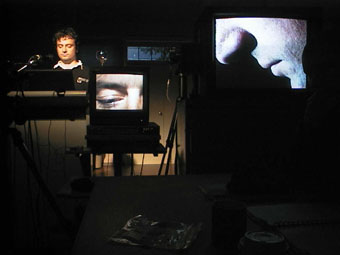
version 1.0, CMI
photo: pvi collective
version 1.0, CMI
Performance is everywhere, not just on stages and screens. Erving Goffman’s descriptions of the forms and strategies of everyday behaviour gained great popularity in the 1970s, prophetically prefacing the obsession with reality TV—some of it unfolding with a realtime liesureliness that makes performance art look positively speedy. Verbatim Theatre has also made a comeback, for example in Company B’s Run Rabbit Run by Alana Valentine (about the rescue of the South Sydney football team from corporate erasure), in Nick Marchand’s work with playwrights in the Sydney Theatre Company’s Blueprints program and in numerous plays across Australia about asylum seekers. In everything from joke-telling, to the patternings of body language and the overt rituals of religion, the courtroom and parliament, there is an abundance of raw material for the artist to distil into…something else. So why not a senate inquiry?
version 1.0’s CMI (A Certain Maritime Incident) is not verbatim theatre but it is a performance devised from the transcripts of the Senate Select Committee Inquiry into the “children overboard” scandal in which, says the company, “6 senators wrestle with their wills, their words, their politics and each other.” Doubtless that means real wrestling and real politics if the company’s first work, the wickedly funny, sometimes searing Second last Supper, a reverie on universal corporatisation, is anything to go by. The text is drawn from the inquiry and is matched, says version 1.0, with a movement score “drawing on physical performance disciplines and sports training to express a bodily, visceral outrage.”
Producer David Williams is critical of the inquiry “for not aiming to uncover the truth, but simply appearing to be doing so, stalling for time, going through the motions. In CMI we seek exposure: to read between the lines, to air the thoughts left in the dark, to seek the faces behind the masks, to hear the questions never said aloud. We ask where is the place for truth in this inquiry? What are the stories we tell ourselves about ourselves through this inquiry? This inquiry talks the talk that numbs the intellect and paralyses the body’s capacity for outrage. CMI is a public act of outrage.”
The company has distilled 2,200 pages of the inquiry transcript successively down to 250 and then 50 pages in editing and workshop sessions. They have also added some words of their own, for example some imagined thoughts from a “lost” senator who never turned up to the inquiry and a “Ruddockesque telephone call.” Williams says the performers are interested in the verbatim approach, but didn’t want to restrict themselves: “We’re not quite that pure and we like to get lost, just like the senators did, starting at 9 in the morning and sometimes finishing [after midnight]and loopy by that time, throwing in stupid jokes…” Williams says there’ll be monologue, for example a bit of Captain Norman Banks’ 30 minute testimony, which never gets round to the children overboard issue. As in the company’s Second last Supper dialogue will be layered with action taking place elsewhere on stage.
In a company with a mixed background of acting and body-based aesthetics, says Williams, there will be a range of approaches to the language of the inquiry, some literal and some quite lateral, ideal ways it would seem to portray contradictions, unmask euphemisms and undo propaganda.
There’ll also be a test for truth. As part of the performance, version 1.0 are using multi-channel video and the Ex-Sense lie-detection software package to analyse the emotional stress in the voice of subjects, displaying continually updated reports on their believability. This is in collaboration with Perth’s pvi collective who have made a performative speciality out of the methods and politics of surveillance.
So what did the language of the inquiry reveal? More of the abstraction and evasion we all encountered in the wake of the “children overboard” incident. Williams says refugees were spoken of not as individuals but only in terms of race or acronyms. The report opens with 3 pages of these including SUNC (suspected unauthorised non-citizen), PIIs (potential illegal immigrants) and UAs (unauthorised arrivals). Half of the people called before the inquiry were from the military and used to thinking this way. More significant, says Williams, “was the Liberal Party’s clear line of attack, bringing volumes of information to cast the asylum seekers in as bad a light as possible, as evil, as engaged in child abuse.” Labor, he said, didn’t seem to have any equivalent strategic approach.
In the end, what was the truth? “Only what we knew already. There was no smoking gun to prove the Howard government as evil as we like to think it.” Howard’s language had already achieved such currency and seductiveness that “it appeared to fit with appearances and our desire to believe ourselves good people”, whatever the evidence to the contrary from the inquiry about misinformation and the origins of published images. The inquiry could do little to break the complicity between a government and its people. Williams thinks that the fact that there was an inquiry was enough to satisfy many people, with “the appearance of democracy at work, justifying the political process.”
Therefore, says Williams, version 1.0 has to propose a problem, for itself and its audience—how to “criticise ourselves and explore our outrage and what paralyzes us—not that self-loathing is necessary.”
But to get at the truth, at what went unsaid, at the appalling complicity that has made asylum seekers’ lives so miserable for so long under successive Australian governments, that is the real task. Much of the theatre that has emerged since the Tampa incident has been strongly felt, but has been mostly a rallying call, if a necessary one, to the converted. Ben Ellis’ Some People for the Sydney Theatre Company promised an undoing of the language that has so knotted Australia into acceptance of Howard dogma, but despite moments of real insight—the everyday turned surreally political—it went down the predictable path of Australian family pathology. Perhaps it’s at the physical-psychological juncture that version 1.0 will hit the personal-political target they are aiming at. version 1.0’s approach can be savagely satirical as well as yielding disturbing imagery. Williams predicts that CMI will be “more anarchic (performatively) and less anarchic (more serious) than Second last Supper.”
In the weeks ahead, as the company completes the work, the big challenge”, Williams says, “will be how to deal, in the final act of the performance, with the drowning of 352 asylum seekers and the question of whether the Australian government was in any way responsible.”
version 1.0 in association with Department of Performance Studies, Sydney University, CMI, performer/devisors Danielle Antaki, Stephen Klinder, Nikki Heywood, Christopher Ryan, David Williams, producer David Williams, dramaturgy Paul Dwyer, Yana Taylor, lighting Simon Wise, video and design Samuel James, sound Jason Sweeney, lie-detection software Kelli McCluskey, Steve Bull (pvi collective); Performance Space, March 24-April 11, bookings 02 9698 7235
RealTime issue #59 Feb-March 2004 pg. 40-
© Keith Gallasch; for permission to reproduce apply to realtime@realtimearts.net
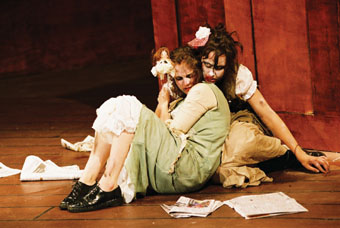
Zoe Coombs Marr and Mish Gregor, Crime Site
photo Heidrun Löhr
Zoe Coombs Marr and Mish Gregor, Crime Site
Murder in the late 19th century criminal “baby farming” industry is the subject of Crime Site, an ambitious collaboration between PACT Youth Theatre and Theatre Kantanka. The show opens at Erskineville Public School with a re-enactment of the school’s opening and a speech declaring the new school “a salvation from crime.” Newspaper sellers announce the discovery of the babies’ bodies and we’re led to a nearby park where metal rods pierce the earth in the search for more victims. In the PACT Theatre the trial of the accused commences, a grotesque set of melodramatic proceedings replete with Victorian prejudices embodied in the roping of the mothers of the dead into an hysterical bundle of grief and guilt. While the killers soon stand condemned (he to hanging, she to life imprisonment, their daughters freed), the women who have handed over their babies to crooked carers are not understood as victims of a cruel society so much as complicit in the murders. The narrowness of this vision is then celebrated in the theatre courtyard as a massive carnival of death, entirely focused on the thrill of the hanging and the erotics of murder. Theatre Kantanka’s facility with spectacle makes this hubbub of sideshows, body organ displays and gross memorabilia a thrilling nightmare as you’re swept about by the curious crowd.
Crime Site is engrossing, if at times demanding for its young but often fine performers. The opening in the schoolyard and the park lacks focus and pace (although there’s a fine speech from Georgie Reid). The courtroom drama is full of clever theatrical devices and nicely crafted movement but the volume of emoting is wearing and the legal figures are characterless if forceful. The daughters of the killers, however, are fascinatingly played by Zoe Coombs Marr and Mish Grigor, all nerves and naivety. Based on the crimes and trial of John and Sarah Makin in the 1890s, Crime Site is not only an intriguing slice of social history, but also provides an entirely relevant analogy to our own times: child abuse is again a prominent issue and capital punishment is back on the agenda, while the Coalition of the Willing’s indiscriminate carnival of vengefulness threatens the lives of many. KG
PACT Youth Theatre, Theatre Kantanka, Crime Site, co-directors Carlos Gomes, Regina Heilmann, Chris Murphy, designer Kate Shanahan, sound Felicity Fox; Dec 3-14, 2003
RealTime issue #59 Feb-March 2004 pg. 40
© Keith Gallasch; for permission to reproduce apply to realtime@realtimearts.net
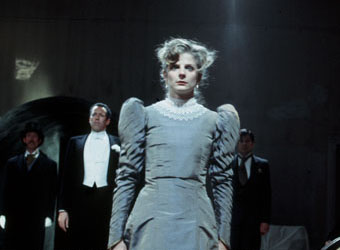
Eleventh Hour Theatre Company, “…yet each man kills the thing he loves”
photo Ponch Hawkes
Eleventh Hour Theatre Company, “…yet each man kills the thing he loves”
Stephen Sondheim has the venomous, working class protagonist of Sweeney Todd sneer: “There’s a hole in the world/ like a great black pit.…./ and it’s filled with people who are filled with shit/ and it goes by the name of London.” Although the dramaturgy of directors/adaptors Anne Thompson and William Henderson is far from Sondheim’s melodrama, Todd’s evocative pronouncement would be an apt introduction to Eleventh Hour’s entwining of An Ideal Husband with The Ballad of Reading Gaol.
After entering the old church hall that is the Eleventh Hour Theatre, the audience turns to face a great, grey cloaca opening onto a murky, patterned floor, across which the sewer’s noisome contents have been vomited—performers, spectators and all. The uncluttered, cream walls and isolated, draped set-pieces dotting the space create the impression of almost heavenly cleanliness, but this is an illusion, resting uncomfortably atop moral sludge. Even this grotesque surface is not without beauty though. Like the blood red flowers that sprout amidst Genet’s poetry, pools of glassy piss are here transformed into golden-hued mirrors, which reflect all the beauty and ugliness of those who walk upon them.
Mary Moore’s design encapsulates the production’s dramaturgy. Oscar Wilde’s at times greyly satiric comedy An Ideal Husband has a strong sense of ‘upstairs/downstairs’, of great moral probity and luxury resting a breath away from hideous reversal into venality and ruin. This undercurrent is rendered in grand scale by juxtaposing scenes from An Ideal Husband with readings from Wilde’s rhythmically unrelenting, tragic ode The Ballad of Reading Gaol. Performer Christopher Brown marches unassumingly yet powerfully out of the pipe’s mouth, and the apparently light feeling of the drawing room space is transformed into a frail conceit. As a well-to-do husband tries to retain his moral renown and hide a single act of youthful corruption, it is clear that he, but for the grace of God, could be the condemned man moving funereally through the mire of prison and poverty. Thompson and Henderson do not so much add something novel to Wilde’s approach (Lady Windermere’s Fan is equally fraught yet light, after all) as deepen this theme through a dramaturgy rich in metaphor, musicality and dialectic contrasts. Where Brown himself barely speaks during The Ballad, his social betters fill the air with fine but superficial talk. Brown is muscular, low and close to the earth, while the others are upright, poised, effete. The staging thus enhances the sense of honour embodied in the guilty, condemned murderer. At least his strong brutality was honest.
The relatively spare, unadorned staging also enriches the impression of theatrical deus ex machina central to Wilde’s theatrical style. Letters and doors become powerful instruments of intrigue and undoing, of action and import. Through them secrets are learnt or from behind them a dizzying assortment of entrances and exits are executed, crisscrossing the space with tension and wit like ribbons from a maypole. By investing so heavily in such small but crucial details, Henderson, Thompson and Moore build a haven for audiences seeking a poetic theatre based in the spoken word.
Eleventh Hour, “…yet each man kills the thing he loves”: The Ballad of Reading Gaol with An Ideal Husband, direction/dramaturgy Anne Thompson, William Henderson, design Mary Moore, lighting Niklas Pajanti, performers David Tredinnick, Fiona Todd, Christen O’Leary, Miria Kostiuk, Marco Chiappi, Christopher Brown, Richard Bligh; Eleventh Hour Theatre, Nov 14-Dec 6, 2003
RealTime issue #59 Feb-March 2004 pg. 42
© Jonathan Marshall; for permission to reproduce apply to realtime@realtimearts.net
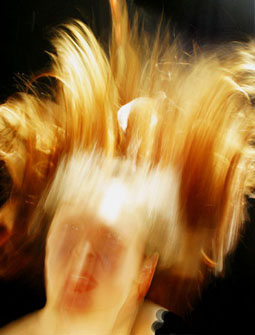
Rebecca Smee, I’ve Got the Shakes
Max Lyandvert and his collaborators did a good job of Richard Foreman’s My Head was a Sledgehammer at Belvoir St Downstairs in 2002, a rare and welcome opportunity to see the work of a modern master in Australia. Although the small space was less revealing of the New York playwright/director’s integral design vision (magically mutating habitats often re-shaped by the performers), the production nonetheless realised Foreman’s manic, jokey, esoteric and sometimes affecting vision. One of the performers in My Head was a Sledgehammer, Melissa Madden-Gray gives a vivid account on page 4 of this edition of Foreman’s latest work at the recent Zuercher Theater Spektakel.
With their associative constructions and broken theatre rules, Foreman’s plays particularly appeal to connoisseurs of contemporary performance and visual art, but they can be refreshing for the jaded theatre palate. In I’ve got the shakes, says the company, “the characters are disoriented, unsure of where the stage begins and ends. They are caught up in inscrutable plots and speak as though they have just begun to learn language. The play only exists in the present moment, and the whole evening is made up of numerous present moments…which invite the audience to refocus their attention and revise their interpretation.” For the characters, performers and audience alike this should prove an entertaining night of metaphysical pratfalls and existential sublimes. RT
Richard Foreman, I’ve got the shakes, director Max Lyandvert, The Darlinghurst Theatre, Sydney, from March 4
RealTime issue #59 Feb-March 2004 pg. 42
© RealTime ; for permission to reproduce apply to realtime@realtimearts.net
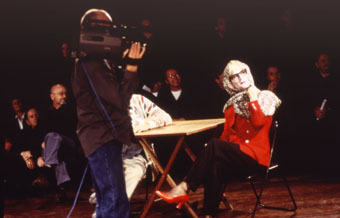
Peter Oldham (camera), Nigel Kellaway, The Audience and Other Psychopaths
photo Heidrun Löhr
Peter Oldham (camera), Nigel Kellaway, The Audience and Other Psychopaths
I thought she was rather attractive in a strange way…She had beautiful manners and a low voice and she smoked incessantly. She didn’t walk or behave in a butch way at all, she was well-bred and had a kind of elegance. Yet her loneliness showed in her face—a cloudiness, an ugliness really—which would go when she laughed, a strange low chuckle. …Sex with her was like being made love to by a boy. Her hands were very masculine and big and she was hipless like an adolescent boy. She wasn’t at all repelled by the male body, she was intrigued by it.
Ronald Blythe in Andrew Wilson, Beautiful Shadow, A Life of Patrica Highsmith, Bloomsbury, London 2003
A vengeful jilted diva (Karen Cummings), a manic female director (Katia Molino) and a drag queen extra (Nigel Kellaway) with a psychotic attachment to the persona of a Hitchcock killer clash on the set of a new film. In The opera Project’s latest music theatre extravaganza, hot on the heels of the popular success of Another Night: Medea (2003), the audience too are extras, cajoled and abused by the director as she shapes her deadly melodrama under the glare of the lights (designer Simon Wise) and through the probing eye of the camera (video artist Peter Oldham). A memorable work-in-progress showing 2 years ago and a slice offered at the Performance Space 2004 program launch revealed a wickedly funny, queer blend of opera, Fellini (or is it Wertmuller, or Caviani?) and Patricia Highsmith a la Hitchcock.
Using a combination of live and pre-recorded visual images the video work will not only suggest the cinematic environment of the narrative and what’s happening offstage but also blur the real and the actual in line with the characters’ fantasies. While the audience will see itself as seen by the camera, each night one male will enjoy the privilege of playing the leading man in the director’s movie-making.
And if that’s not enough to whet your appetite for blood and hysterics in a swirl of red roses and big screen camera gyrations, performance poet Amanda Stewart has co-written the off-beat libretto. No stranger to new music, Stewart is a member of the Machine for Making Sense ensemble and in 1997 she created The Sinking of the Rainbow Warrior with composer Colin Bright.
The musical score for The Audience & Other Psychopaths is by Sydney-based composer Stephen Adams. His participation is a welcome new dimension to The opera Project’s predilection for radical displacement of opera classics from the 17th to the 19th centuries into the 21st. Adams’ task is a very special one, to compose for the “disembodied voice.”
Director Nigel Kellaway says he’s always seen opera as “an intensely physicalised theatre form,” especially in the sheer physicality of the voice. One of the original intentions behind this work when it was first conceived, some 4 years ago, was to tackle the “disembodied voice” in performance. But the problem, as Kellaway saw it, was how to corporealise it so that the audience could treat the voice as a serious entity even if they couldn’t see where it was coming from. They could at least imagine the body and the place from which it was emanating. The solution is to offer a few character and narrative hooks. This woman is in the dressing room, refusing to come on stage. “Is she the ex-lesbian mother of the B-grade film auteur? Or a fantasy voice from the film director’s neurotic desire to be loved, loved, loved?” asks Kellaway.
The disembodied voice is performed by Cummings. In fact, save for a passage from a Rossini overture accompanying the filmmaking, the music and the soundscore for the work entirely comprises a pre-recorded Cummings singing Adams’ compositions and delivering Stewart’s text. Kellaway describes Adam’s creation as “a huge choral work for a single and multi-tracked voice.” No musical instruments are used.
Stephen Adams has a background in choral music, experimental rock bands and theatre, as well as training in formal composition with Peter Sculthorpe. His exploration of the human voice includes two major a capella works, Memory Pieces (1995) for the Sydney Chamber Choir, produced on CD by Tall Poppies and performed across Canada in 1999 by the Canadian Ensemble de la Rue, and Desires: Movements Toward The Divine (1997) for the Song Company, premiered live on ABC Classic FM Radio and performed on tour in Italy.
Adams says that his major focus as a composer has been on the voice whether solo, choir, in music theatre or digitally interpreted. In particular he’s interested in music’s relationship to other things, especially the texts of performance poets such as Amanda Stewart and Ania Walwicz. He likes “the obsessive quality they share about language, kicking between semantic overload on the one hand and discarding it on the other,” pushing language to the limits but “demanding it say things as clearly as possible.”
For The Audience & Other Psychopaths Adams recorded his own long vocal improvisations, wrote them down with modifications and gave these “relatively fully developed melodic lines” to Cummings whom he recorded. He edited and organised these fragments, changed the pitch here and there and began to shape the overall soundtrack for the performance. Some of the pieces “became independent lines and some of the sounds slough off and have a life of their own as Karen’s voice continues on.” As the performance progresses “the space gets more and more sonically cluttered with bits of her, as opposed to the opening where she’s in one naturalistic space, the dressing room. This shifts to become an aurally omnipresent soundscape.”
As ever, The opera Project will offer strong performances, this time from artistic director Kellaway whose extensive career in performance is founded on majors in piano and composition at the Universities of Melbourne and Adelaide, training in performance with Tadashi Suzuki and his Suzuki Company Of Toga and with Min Tanaka in Tokyo. Katia Molino trained in corporeal mime (and performed with Entr’acte Theatre), with Suzuki Tadashi in Japan, in stiltwalking and aerial techniques (working with Stalker and Marrugeku) and recently performed in Stalker’s Incognita at the Perth and Melbourne International Arts Festivals. Soprano Karen Cummings is committed to performing contemporary music. She has sung in opera, cabaret and recital, appearing as a soloist with the Victorian State Opera and Opera Australia and performing the premieres of several Australian works including Andrée Greenwell’s Laquiem at The Studio, Sydney Opera House (1999).
Outside Opera Australia and Pinchgut Opera’s delivery of the classics and rare productions of new works from Music Theatre Sydney, it’s The opera Project that music theatre audiences are increasingly turning to in Sydney for pleasure and provocation. Amidst the rude hubbub of New Mardi Gras 2004, The Audience & Other Psychopaths should provide lovingly crafted and memorable transgressions of every kind: “Archetypes to offend everyone in the gay community,” quips Kellaway.
The opera Project, The Audience & Other Psychopaths, part of New Mardi Gras, Performance Space, Sydney, Feb 10-21
RealTime issue #59 Feb-March 2004 pg. 43
© Keith Gallasch; for permission to reproduce apply to realtime@realtimearts.net
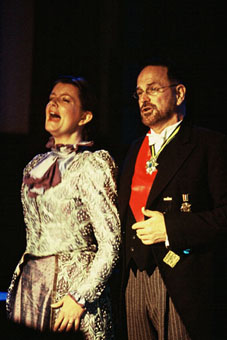
Jeannie Marsh, Grant Smith, Love, Death, Music and Plants: A musical infringement on the life of Baron Ferdinand von Mueller
photo Rachelle Roberts
Jeannie Marsh, Grant Smith, Love, Death, Music and Plants: A musical infringement on the life of Baron Ferdinand von Mueller
Love, Death, Music and Plants is the latest production from writer/director Brian Lipson. Continuing the style Lipson developed for his solo performance A Large Attendance in the Antechamber (2000), the dramaturgy and mise en scène of Love, Death… functions according to an essentially museological logic. Lipson’s staging is consistent not only with his chosen topic, but also with the building which houses the piece—the National Herbarium of Victoria. Lipson creates a space within which characters, words and songs are mounted and placed within semi-static tableaux.
The opening image of the former botanist and director of the Herbarium laid out on a wooden slab like one of the many specimens that surround him, fussed over by the botanists of today, remains in the eye and senses of the audience throughout the performance, imparting a density and materiality to this production which summons those ghosts that adhere to objects and spaces from across time. The depth of this museological approach is strikingly effective—every movement and every gesture has a firmness and weight through Lipson’s careful judging of spatial volume and depth for each on-stage position. Diagonals from corner to corner, horizontals at the back or slightly forward of the rear wall carefully offset pairings and other directional axes: these are the coordinates of 19th century rationalism, science and botanical classification embodied in Lipson’s dramaturgy.
The set elements and objects (tables, cases, dresses, hats, coats, specimens) do not so much dance within the performance as move along invisible yet fiercely determined corridors within the space. It is here that the libretto, music and especially the use of voice is so crucial. Love, Death… is not just an homage to 19th century Victorian botanist Ferdinand von Mueller. It is also a critique of the man and his values. Alongside this dramaturgical clarity of line and space which the display of specimens in museums and herbaria has embodied since Mueller’s time, there is also a sense of the poetic, of flow and dance, as the voice and the score play with the conventions of classicism, opera and gentle atonalism.
The closing image of Mueller, dressed in glowing, spectral white, standing in the gardens outside the Herbarium while singing in falsetto to a spreading Moreton Bay fig perfectly reciprocates the opening tableau. Here the dreams of the earlier prone, sleeping figure are allowed full flight in the form of pure voice and sound, in speech and text which strokes and seduces the surface of the bark and the ear.
This interplay between 2 models of life and experience—the rational and the poetic—is most fully realised when Mueller sings to his would-be fiances. The botanist becomes Pygmalion, but at several key points it’s he who is transformed, shaped and classified by his feminine role models, rather than him sculpting them into his ideals. Mueller’s first rejected fiance, Euphemia Henderson, dresses herself in the botanist’s own authoritative top hat and coat to sing in loud, sour, sarcastic tones of how she/he “picks” and “dries”, “samples” and “presses”: “I grunt … I groan,/ sleep briefly, excrete infrequently,/ eat bleakly alone…/ …and worship / a white goddess.” As Mueller himself takes up similar themes, a degree of vocal and imaginative transvestism creeps into the performance.
The clear distinctions of Mueller’s professional life, between sedges and heaths, eucalypts and deciduous, break down at the most fundamental distinction within his personal life: between man and woman, husband and wife. Mueller is in the end “unsexed” by his own obsessive actions—like Lady Macbeth, though less violently. It is therefore finally both Lipson and we, the audience, who mount Mueller on a pin; who turn him one way and another to gaze at his barked sides. The spectator and the director come to stand in for Euphemia, effeminising the great man as we hear his voice slip out of conventional masculine range. Love, Death… thus not only unleashes the expansive genius of 19th century science and classification, but also the demons and sprites that dwelt deep within their roots; the poetic beauty of a vision of an orderly universe mapped and possessed, as well as the tragedy that lurked within the didacticism and impossibility of this project.
Love, Death, Music and Plants: A musical infringement on the life of Baron Ferdinand von Mueller, director/writer Brian Lipson, composer Matthew Hindson, musical director Mark Shiell, lighting Chris Sanders, design Andrew Bailey, producer/performer Jeannie Marsh (Euphemia Henderson), performer Grant Smith (Mueller), The Baron’s Choir; Mueller Hall, National Herbarium of Victoria, Nov 18-30, 2003
RealTime issue #59 Feb-March 2004 pg. 44
© Jonathan Marshall; for permission to reproduce apply to realtime@realtimearts.net
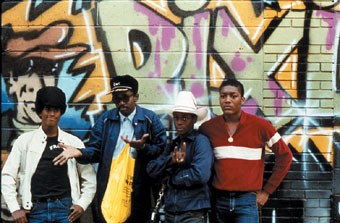
Fab Five Freddy and his crew, Wildstyle
From the time hip hop was an underground phenomenon known only to a few New Yorkers, film has played an important role in recording and propagating this urban subculture. Celebrating the audio-visual side of hip hop culture, the inaugural Hip Hop Film Festival plays in Sydney and Melbourne over 2 consecutive weekends in February and March.
Showcasing the latest in contemporary hip hop cinema, the festival also aims to give some historical perspective on a form that is now more than 2 decades old. Movies like Beat Street and Krush Groove helped bring hip hop to international attention in the mid-1980s, but several smaller-scale New York films pre-date these Hollywood releases, capturing the fashions, graffiti art and personalities of New York’s nascent hip hop scene before it broke across America. One of the earliest films, Wild Style, will screen at the festival. A docu-drama from 1982 directed by Charlie Ahearn, Wild Style features several early hip hop performers including Grandmaster Flash, the Rocksteady Crew and Fab Five Freddy.
In a more contemporary vein the festival will be screening Joslyn Rose Lyons’ recent documentary on ‘underground’ hip hop, Soundz of Spirit. Lyons’ film features interviews with such hip hop luminaries as Michael Franti and members of Outkast and Jurrasic 5. The burgeoning local scene will be examined in 3 Australian documentaries: Sprayed Conflict (directed by Robert Moller), Street Level (Madeleine Hetherton) and All the Ladies (Colleen Hughson).
In presenting works from over 2 decades the festival will trace hip hop’s often controversial history and the political undercurrents that have fuelled the culture on its journey from the streets of New York to MTV screens around the world. RT
2004 Hip Hop Film Festival, Valhalla Cinema, Sydney, Feb 26-28, ACMI, Melbourne, March 4-6, www.hhff.com.au
RealTime issue #59 Feb-March 2004 pg. 44
© RealTime ; for permission to reproduce apply to realtime@realtimearts.net
The rise of Melbourne bar culture has enabled new music, sound art and anarcho-jazz to establish a foothold in the city—notably in the northern side streets behind the Windsor Hotel (Meyer’s Place Bar, the Loop Bar etc). The Loop is a way-cool, lounge-style bar with impressive AV capacities, making it ideal for relative newcomers Transparent Means, an ensemble led by keyboard player Alex Carpenter and electronics and percussion manipulator Russell Goodwin. The duo is particularly influenced by 1950s/1960s musique concrete ideas about texture, minimalism, repetition and “microsonics” (ie very small, slow shifts of texture, timbre, tempo or quality). Their most recent performance featured electronica classics by key composers of Fluxus, John Cage (Fontana Mix) and La Monte Young (The Melodic Version of the Second Dream of the High-Tension Line Stepdown Transformer).
Wearing their historical influences on their sleeves, Transparent Means’ music appears somewhat dated and yet the microtextural investigation of well-worn motifs allows for extremely subtle and expansive ways of interpreting the technology through which such musical ideas may now be realised.
In their most recent performance Transparent Means included striking imagery by Michael Carmody, including a particularly beautiful sequence featuring spreading, abstract blots of light and colour on a black background for Young’s The Melodic Version. Like many aspects of this ensemble’s work, though, this needs further development. Carmody’s video materials consist of a series of fully-prepared tapes which are simply set going at the beginning of each composition, radically reducing the possible interactions between sound and vision in a live environment.
Perhaps more importantly, in all 6 pieces they performed, Carmody’s accompanying imagery was drawn from relatively circumscribed sources (footage of an old woman at the hairdresser, a bike in a park, urban landscape through train windows or from the streets). Several of these were the same, unprocessed source materials that he has manipulated, flared and distorted for other Melbourne commissions—notably his projection for director Bagryana Popov’s excellent community theatre piece Stories From the Hidden City (Melbourne Museum, 2002). Carmody therefore needs to record some new raw footage and to mix his video materials live if his work is to fully support the structured, minimalist, Fluxus-style improvisations currently championed by Transparent Means.
Carpenter provides the most visibly interesting contribution to the events as a performer and composer. His principal technique involves using his keyboard as a triggering device for slow, predominantly chordal changes characterised by extreme overdrive processing, which makes the organ notes sound similar to electric guitar feedback. These materials are allowed to accumulate and decay, or are given a wave-like throb through the use of delay, reverb and similar methods. Goodwin on the other hand works predominantly from behind a small mixing desk connected to other pieces of electronic equipment. His various theremin-like electronic punctuations and his mixing of layered audio static provide both a satisfying depth and various temporal markers within Carpenter’s more clearly enunciated contributions.
Apart from the as yet unresolved relationship to history embodied within the work of Transparent Means, the group needs to address pragmatics and staging. It is a sad indictment of the electronica sound art world along the Australian south-eastern seaboard that so few shows start on time and most are characterised by frankly embarrassing intervals during which musicians and roadies battle to make their equipment function properly. The 2003 iaudio concerts showed it’s possible to smoothly swap from one ungainly mechanism to another, yet most other sound art performances like What Is Music? and independents such as Transparent Means seem incapable of planning a sound check prior to the performance.
Despite shortcomings, Transparent Means makes an important contribution to Melbourne sound culture by reinjecting Fluxus influences through what might be considered the sonic, electronica equivalent of “rough theatre.”
Music of Transparent Means, performers Alex Carpenter, Russell Goodwin, projection Michael Carmody; Loop Bar, Melbourne, Nov 25, 2003
RealTime issue #59 Feb-March 2004 pg. 45
© Jonathan Marshall; for permission to reproduce apply to realtime@realtimearts.net
The significance of The First Australian Percussion Symposium and Eisteddfod cannot be underestimated. It was a gathering of around 100 students, performance groups and teachers of national and international standing in a week of workshops, eisteddfods, scholarly papers and celebrations of the variety and virtuosity of recent contemporary percussion practice.
In many cultures, percussion music (whether generated via instruments, or directly from the human body) has a spiritual and cultural significance that lies well outside Western parameters of ontology. In Bali, China, Japan, Africa and the Middle East, percussion is often intrinsically linked to the calling up of gods, spirits, daemons and the appeasing of illness. Perhaps the closest parallels in Western experience are practices such as raves and dance parties, where participants enter different states of consciousness from those of habituated daily perception.
Perhaps what John Broomfield (Other Ways of Knowing, Inner Traditions International, 1997) calls our propensity to classify knowledge as either “scientific” (provable) or “hysterical” (indigenous, intuitive) is part of the reason why percussion has traditionally stood as the dogsbody at the “poor man’s desk” of the orchestra. Despite the extraordinary versatility of percussionists (they seem able to play everything, from broomsticks to sirens, Chinese zithers to Taiko drums), players talk of traditionally disparaging attitudes from conductors and other instrumentalists. The attitude of composers also reflects this disparagement, with only the most recent of compositions calling on much more than 15 minutes playing time within a 3 hour performance or rehearsal call.
Yet, like architecture, percussion has the potential to communicate some aspects of knowledge and experience more directly than artforms reliant on structures of melody, harmony and narrative. This leaves percussion open to exciting cross-cultural improvisations.
At the symposium, international players Michael Udow, Mark Ford and Steve Schick were generous in their teaching and performances, demonstrating the extraordinary scope of performance work available for percussion. Local teachers/performers and composers included Gary France (Symposium Convenor and Head of Percussion, ANU), Michael Askill, Daryl Pratt, Peter Neville, Tim White and Vanessa Tomlinson. The astonishing variety and virtuosity of compositions included works from Udow, Ford, Schick, Endo, Bartok, Lim, Smetanin, Pollard, Antheill and Pye, as well as improvisations.
The final concert was a highlight, showcasing conservatorium/university and independent professional ensembles from across Australia, such as the engaging portable-drum-thrumming Karak Duo (Brisbane) and the dynamic and hyper-energised Tetrafide Percussion from WA, who proved as capable with broomsticks as with South Indian drums.
Steve Schick embodied the intensity of Iannis Xenakis’ work, performing Psappha as if he were strung and pulled with high-tension wires.
Ford’s Stubernic transposed Caribbean street performance practices into a joyful yet delicate composition which saw 3 players on one marimba slipping like butter around each others’ bodies. Wyana Etherington and Jessica Dai from ANU performed with remarkably cool aplomb.
Udow’s Coyote Dreaming explored the Colorado canyons as if the marimba were an animal, played with dynamism and an admirable combination of discipline and release by Elder Conservatorium’s Fleur Green. Udow’s solo piece, Tennei-ji, based on a Noh drama, is virtuosic in its demands, with 3 speaking/singing characters embodied in one performer playing marimba. Garbed in kimono, wig and painted mask, Udow displayed an extraordinary combination of discipline and transformation, rendering the marimba a trans-cultural instrument both Oriental and Occidental. Michael Askill, a long-standing inspiration as performer, composer, teacher and mentor to generations of Australian percussionists, composed and directed the Finale. This finely-staged work combined a knowing theatricality (dozens of church bells travelled from all entry-points in the auditorium towards the stage) with an exploration of sound densities. The roaring, rolling final movement saw all 120 participants in the symposium playing at once. The miracle of this piece was that despite its extraordinary volume and power, it managed to remain as intimate as a string quartet. The work ebbed and flowed, alternating between a meditative delicacy (a short, integrated reading of Calvino poems dropping like liquid from Udow and Schick quietly sitting at the front of the stage) with vibrant, Taiko-like volume and passion. That such a dynamic and edgy performer as Schick could rest in such quiet in his role was a symbol of the humility that characterised the week as a whole.
This was a week of great complexities that explored the peculiar and special place that the lowly percussionist, emerging into virtuosic realms, now holds. The symposium provided a valuable forum for the peculiar risk involved in percussive improvisation.
The First Australian Percussion Symposium and Eisteddfod, director/convenor Gary France, ANU School of Music, Sept 22-29, 2003
RealTime issue #59 Feb-March 2004 pg. 46
© Zsuzsanna Soboslay; for permission to reproduce apply to realtime@realtimearts.net






















